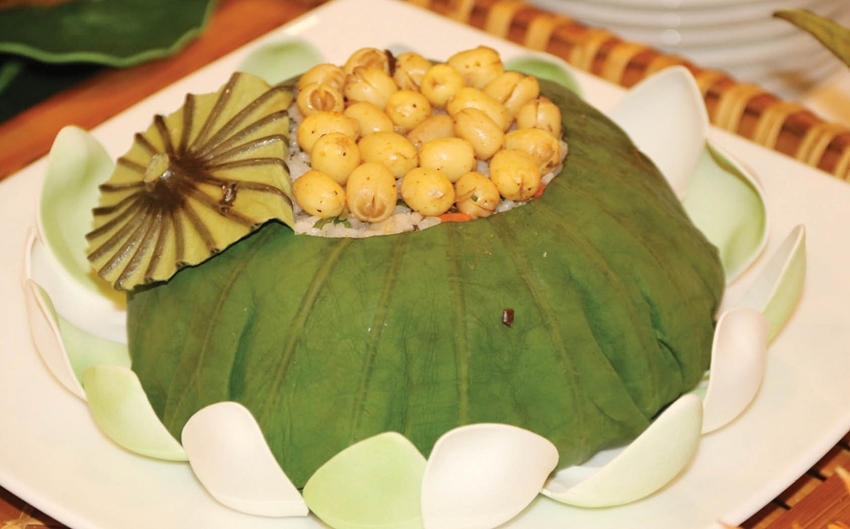 |
| Lotus leaf steamed rice. Photo: Huu Phuc |
The "kitchen" of Vietnam
Hue is renowned for many fields that could serve as the basis for its application to the UNESCO Creative Cities Network, such as Ao Dai, handicrafts, and music, etc… Then, the city chose cuisine, arguably it is the most outstanding and feasible field, to build its profile.
It is the most outstanding because, even though the Michelin star system has not yet reached Hue like it has in other cities such as Hanoi, Ho Chi Minh City, or Da Nang, when it comes to Vietnamese cuisine, one cannot ignore Hue's culinary. And this recognition is not just empty pride; it is supported by numbers and events.
For instance, at the ceremony to announce and award certificates for Thua Thien Hue's exemplary dishes in Phase I - 2022, and to launch the voting period for Phase II - 2023 of the “Journey to discover Vietnam's culinary cultural values” and to award membership certificates to the Thua Thien Hue Culinary Culture Association, organized by the Vietnam Culinary Culture Association, Hue had the most recognized dishes, including Bun bo Hue (Hue beef noodle soup), Che Bot loc boc Heo quay (pork wrapped in tapioca flour pudding), Com hen (mussel rice), Banh loc (clear shrimp and pork dumpling), Va tron hoa mau chay (fig salad), and Com hap la sen chay (vegetarian lotus leaf steamed rice).
Not only that, Hue is working towards becoming the “kitchen” of Vietnam based on the fact that out of approximately 3,000 dishes across the country, more than 1,700 are cooked in the Hue style! Furthermore, Hue was the capital of unified Vietnam beginning in 1802, when Emperor Gia Long established the Nguyen Dynasty. Hue served as the royal court's cultural, artistic, and culinary hub throughout the Nguyen dynasty, including its culinary arts to serve the daily needs of the royal court.Only in Hue has cooking been elevated to an art form, establishing a cultural brand with profound and important concepts. Hue's cooking has been elevated to a higher level of value, a necessary attribute for women...
Of course, for Hue to successfully join the UNESCO Creative Cities Network, there is much work to be done. And, we can be assured that Hue has shown it is well-prepared with organized symposiums, workshops, and international conferences to finalize the application, including two symposiums and one workshop scheduled for August and September 2024 and an international conference titled “Hue - Towards a Creative City in the field of cuisine” planned for December 2024 to gather feedback and consultation on the relevant content during the application preparation process.
Following the submission of the application, the city will carry out activities such as publishing materials, books, and documentaries to introduce Hue's culinary potential; organizing culinary spaces; showcasing activities; and cooking traditional and royal dishes to promote Hue's potential in the field of culinary culture...
Cuisine as a cultural industry
The UNESCO Creative Cities Network was established in 2004 to promote international cooperation between cities recognized worldwide, using cultural resources and creative culture as the foundation for sustainable urban development. Currently, more than 350 cities from over 90 countries and territories are part of this network, working towards a common goal: placing creativity and cultural industries at the center of local development plans and actively cooperating internationally.
In Vietnam, the proposal and promotion of cities to join the network, such as Hanoi in 2019 (creative design city), Da Lat in 2023 (creative music city), and Hoi An in 2023 (crafts and folk-art city), as stated by Minister of Culture, Sports, and Tourism Nguyen Van Hung, are part of the strategy to develop Vietnam's cultural industries by 2020, with a vision to 2030 approved by the Government. These are strong foundations for Vietnam to set a goal in the next phase to become a hub of cultural industries that attract and gather creativity in Southeast Asia...
In this sense, if Hue successfully joins, many opportunities will present themselves, including exchanges, integration, and cooperation with 350 other cities worldwide, not only in the culinary field but also in the other six creative fields of the network, contributing to realizing the goal of making Hue the “kitchen” of Vietnam and other objectives.
Hue's cuisine stands out compared to many other localities, having been recognized as a “cultural brand.” However, to be part of the UNESCO Creative Cities Network, Hue's cuisine must be upgraded to a “tourism brand” and further developed as a product of the cultural industry. At this point, cuisine is no longer just a brand to boast about or to take pride in among friends but must become a product - an ecosystem that can generate significant income for the people and the locality.
The practical results from the initial successes of Hanoi, Hoi An, and Da Lat demonstrate that for Hue's cuisine to transition from a “cultural brand” to a cultural industry, it requires the involvement of the entire political system and the community with a concerted and well-planned approach. The UNESCO Creative Cities Network is not just a title but a process, where the word “creativity” is at the center of every decision!
